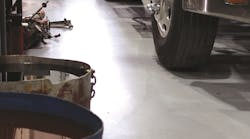Not so long ago, a trucker’s ability to handle a wrench was almost as important as his or her skill with an 18-speed transmission. And for many owner-operators, even today, the ability to maintain older equipment is the difference between making a living as an independent or filling out driver applications for a fleet job.
But, with the increasing complexity of modern tractors—to say nothing of improved performance, quality, and reliability—the opportunity for substantial maintenance and repair is going the way of the manual gearbox. Simply, a lot of drivers today don’t see the need, nor do they have the skill, to work on their own rigs. Yet it can be done, and there are benefits to DIY.
“They’re smart and they have amazing skills, but they just need to be refocused,” says Kenneth Calhoun, vice president, customer relations, for Truck Centers of Arkansas. “They’re just going to be looking for different things. When you think about the internal hardware, it is more robust than it’s ever been. The B50 life is up to 1.2 million miles, meaning more than half of the trucks being built today are lasting that long.”
Calhoun is also a director-at-large for the Technology & Maintenance Council (TMC) board of directors, as well as the immediate past chairman of TMC S.16, the service provider study group. So he knows a little about maintaining and repairing heavy-duty commercial vehicles.
“I’ve been around enough old two-stroke Detroit Diesels on the dyno that I’m nearly deaf on one side,” he quips. But equipment is now superior.
Many long-time truckers started out with tractors powered by “big Cats,” or Caterpillar diesel engines, and had to roll the rods and main bearings at 500,000 miles—“but you don’t do that today, not on anybody’s engine,” he explains. “We still need the talent, but rather than the guy that wants to rebuild the pump or those sorts of things, we just need them directed at what are the weak links now.”
He’s quick to point out that diesel particulate filters (DPFs) have been in heavy-duty diesels for 10 years now—and owner-ops may often deride emissions restrictions and the ensuing complex exhaust aftertreatment systems—but a truck buyer’s options are increasingly limited.
“Unless you’re really into restoring old equipment, guess what?” Calhoun says. “And aftertreatment is the most maintenance-intensive and expensive part of the equation today.”
Indeed, the most common issues Calhoun sees in his shops stem from idling. And, for drivers who might be doing more sitting in their trucks than running them, idling can be a real problem—much more so than in previous generation diesels.
“Idling’s never really been good, but the only things that used to happen was you had some turbo-slobber. Today, that goes into the aftertreatment system. Sooner or later, you’ll find yourself at 80,000 lbs. pulling a grade, and the computer says it’s time to do a re-gen,” Calhoun says. “You’ve got all this accumulated hydrocarbon in that system, and the next thing you know you’ve cracked the substrate on a DPF and you’ve fried the SCR catalyst—you’ve trashed it. Idling is cooking some very expensive equipment.”
So anything that can be done to reduce idling (and to follow manufacturers’ aftertreatment guides) will make for a longer-lasting system.
Overall, sensors remain “the weakest link” in modern truck systems, and the mechanically inclined “absolutely” should be able to inspect the wiring harness for chafing, for example, or for road salt getting into connector packs, Calhoun adds.
Telematics advantage
Yet modern electronics, while taking away the accessibility of more simple mechanical systems, also provides an upside in telematics capability—even for owner-ops and small trucking companies. Indeed, Calhoun “takes exception” to the notion that on-highway diagnostics and reporting tools such as Detroit Connect Virtual Technician are geared to big fleets. “The methodology from Day 1 has been: I have a truck with a problem—what am I going to do about it?”
An owner-op with such a system is going to get a notice on his smart phone that tells him exactly what the fault code on the dash means, what needs to be done, and how quickly, along with the contact information for the nearest service options.
“In my mind, [a remote diagnostics system] is the ultimate owner-operator tool,” Calhoun says.
And, thanks to the Internet, DIY diagnostics is much simpler as well.
“You take a fault code that’s in the generic SAE format, the SPN/FMI [Suspect Parameter Number/ Failure Mode Identifier], and just Google it and you’re going to find all kinds of pertinent information. Then plug that into YouTube and you can be amazed,” he says. “The DIY guy has always had the tools he needed to tinker with, and with OBD-II [the latest onboard diagnostics protocol] the ability to extract that data is incredibly valuable. It’s just the latest systems are different. Instead of being wrench-first, since we know that it’s our harnesses and our sensors that give us more trouble than anything else, you’re just applying a different skill set.”
For another tip, fuel quality remains a prominent issue that must be monitored on a daily basis, Calhoun suggests. “The guy who has the smarts to look at that frame rail-mounted fuel/water separator or the water fuel indicator on the engine-mounted platform can say, hey, ‘this is an alarm I need to do something about.’ Because of what we’ve had to do with injection pressures to get the fuel atomized to burn efficiently, that’s massive pressure—and water doesn’t compress. You’ll blow the tips off of the injectors.”
Knowledge is power
Similarly, “people who understand the mechanics” should be aware that PM schedules aren’t carved in stone. Daimler Trucks North America (DTNA), for example, provides options based on engine-load percentages and fuel economy ratings.
“Pull that manual out and look at the parameters before you set your oil drain interval,” he says. “Is this a severe-duty application, or is this purely all-highway easy miles. Answer those questions honestly. Those advertised intervals are not a one-size-fits-all.”
More broadly, especially in terms of working with several service providers, Calhoun emphasized the importance of uniformity in maintenance.
“If you’re bouncing around and you hit that OE dealer, then Speedco the next time, and somebody else the next, you’re forfeiting any consistency in the inspection,” he says.
As a member of the TMC board, Calhoun doesn’t hesitate to encourage owner-ops to join—with membership costs running “significantly less” than for fleets, service providers, or associate members.
“It is a very good deal. You have access to a lot of recommended practices and information like maintenance forms,” he says. “At the end of the day, it’s still the equipment. The advantage that the fleets have simply comes from the number: They’re going to see the problem surface over a group of vehicles as they accumulate millions of miles. When you come to TMC, you have access to that information as if you were operating 2,000 trucks instead of 1 to 5.”
As for owner-ops’ ability to hang on to less complex, previous generation engines by buying glider kits, the latest round of federal emissions regulations for heavy-duty vehicles will greatly limit the options.
“The glider will go back to what it was originally designed for: You wreck a truck, the body’s totaled, but you still have usable components,” Calhoun says.
Stopping power
Of course, truckers are in the business of moving freight and engine power gets all the glory, but the ability to stop is a big part of highway safety. So truck braking gets a lot of attention from the Federal Motor Carrier Safety Administration; brake systems are high on the roadside inspection list.
During Brake Safety Week last fall, enforcement members of the Commercial Vehicle Safety Alliance reported 13.2% of inspections with out-of-service brake violations—so some remedial education is clearly in order. But there’s more to wheel-end performance than doing the minimum.
“The things that generally get caught in a pre-trip inspection are the obvious ones: loose and hanging hoses, air leaks, things of that nature,” says Keith McComsey, director of marketing and customer solutions, Wheel-End, Bendix Spicer Foundation Brake. “But to make sure the equipment is working the way it should be, or to avoid CSA-type violations, you need to look beyond the pre-trip. Whether it’s something to look at once or twice a week, or key maintenance opportunities when the vehicle is in for service—that’s where you have the chance to catch things.”
Unlike the move to electronic controls and digital black boxes in modern engines, wheel-end hardware is still basically mechanical—and so it’s an area where an owner-op can still play a big role in maintenance—at least in terms of the foundation brake.
“But when you get into ABS and some of the electronics, that might be a little bit different,” McComsey says. “Brakes are still things that are easily done by a mechanical person.”
While drum brakes have been around a long time, a DIY trucker might not be as familiar with modern heavy-duty air disc systems, he adds.
In terms of preventive maintenance, someone new to the system needs to pay attention to the calipers, guide pins, and brake pad wear, an inspection that can be done when a wheel is off.
And “catching things early” is critical to performance and longevity. For drum brakes, “dragging brakes” are a primary concern, while sticking to a PM schedule is all the more important for air discs, he suggests.
McComsey also emphasizes that vehicles built to the federal reduced stopping distance (RSD) standard must have RSD-rated replacement materials, such as the brake shoes.
“In order to keep the same effective stopping distances, you need to get like-for-like,” he says. “The OE-level friction gets you to the stopping distances the vehicle had when it was manufactured.”
Indeed, truck operators should be cautious about buying less expensive but “low quality” replacement parts.
“Always ask if [a part] meets certification requirements,” McComsey says.
Wheel-end inspection
McComsey and Bendix provide the following tips, beyond the basic pre-trip points, for effective inspections that can be done once or twice a week without removing the wheel:
- Check air disc brake rotors for cracks, and check guide pin boots and tappet boots for cracks or tears that could allow moisture inside.
- Inspect for cracks and lining wear on drum brakes without dust shields.
- Other key points:
- Examine drums and rotors for signs of dragging brakes or overheating linings. Signs include grooving on air disc brake rotors or leopard-spotted patterns on drums.
- Do not manually adjust automatic slack adjusters. There are several factors that can cause a brake to overstroke, but none of these will be fixed by a manual readjustment.
- Watch for uneven friction wear on drum brakes, where it can indicate a deformation in the brake shoe.
Electronics and controls
Advanced safety systems may not provide shade-tree mechanics with many chances to tinker, but all truck drivers need to be aware of proper maintenance, as well as the proper use of the life-saving technology.
“The road to safer vehicles may begin with new technologies and improved braking components, but it also requires supporting them through proper maintenance and ongoing, proactive training and technical knowledge,” says Fred Andersky, Bendix director of government and industry affairs. “The best-equipped vehicle out there is not running at its safest without the right upkeep and know-how both in the garage and on the road.”
Following are some suggestions offered by Andersky.
External components:
- For vehicles equipped with advanced safety systems such as collision mitigation technology, check the forward-facing radar sensor to ensure its field is free of debris and other obstructions.
- Be familiar with the recommended procedure for aligning a forward-facing radar sensor.
Inside the cab:
- Know the vehicle systems’ blinking light fault codes and how to address them. Antilock braking system (ABS) warning lights convey key information on problems with components such as wheel speed sensors. If the vehicle is equipped with traction control and stability systems, the traction control/stability lamp will indicate any issues.
Tire tips
Since tires are often the biggest operating expense after fuel, a lot of money is riding on those wheels, notes Gary Schroeder, director of Cooper’s truck and bus tire business, which includes the Roadmaster brand.
After all, a typical tractor-trailer runs 18 wheel positions. The owner’s investment in tires is worth protecting, and it’s worth knowing how to maximize performance based on operational factors. Taking into account overall tire performance for the application, including miles to removal and retreadability, there’s a lot to consider. Many times, certain factors can, and should, be monitored on a daily basis. Schroeder talks about a few of them:
Maintain proper tire inflation. The No. 1 tip for long tire life is maintaining proper inflation. The key to a good tread footprint and even tread wear is maintaining proper inflation. Both over- and under-inflation have a negative impact. The proper inflation figure should be determined by taking into account actual weight by axle and using a load/inflation table.
“A chart is a great tool to utilize; it will pay dividends. This is not the old ‘100 psi works for all’ scenario.”
One more thing to consider, even if you’re using an automatic inflation system, is that you still need to check your inflation pressure on a regular basis. Don’t assume the tire inflation is perfect, especially if you have mismatched dual assemblies. Roadmaster recommends checking tire condition and pressure on a weekly basis, before each trip and daily during continuous service.
Rotate tires on a routine basis. The second tip to longer tire life is to routinely rotate the tires, especially in areas of irregular tread wear. Roadmaster recommends rotating tires when they are 50% worn, or even earlier if they show signs of irregular wear. Steer tires are normally rotated side-to-side, which changes the direction of rotation and helps even out wear.
Check for irregular wear. While rotating tires can help, you still need to investigate what is causing an irregular wear issue. When tires are not wearing evenly, fuel economy will drop. Irregular wear also causes vibration and ride disturbances and eventually reduces mileage and increases your costs.
Check total vehicle alignment. To keep tire wear even, vehicle alignment should be checked every 80,000-100,000 miles or 12-18 months.
TMC provides good information on tire wear, including photos, Schroeder suggests.




